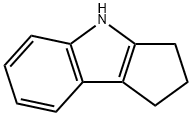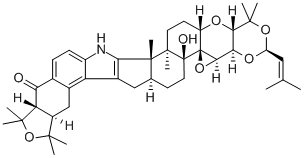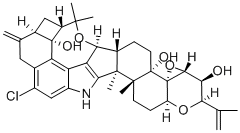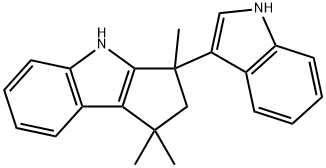1 2 3 4-TETRAHYDROCYCLOPENT(B) INDOLE
- CAS NO.:2047-91-8
- Empirical Formula: C11H11N
- Molecular Weight: 157.21
- MDL number: MFCD00225387
- SAFETY DATA SHEET (SDS)
- Update Date: 2023-06-08 17:06:37

What is 1 2 3 4-TETRAHYDROCYCLOPENT(B) INDOLE?
The Uses of 1 2 3 4-TETRAHYDROCYCLOPENT(B) INDOLE
• ;Reactant for thionium species-mediated functionalization at the 2α-position of indoles1• ;Reactant for preparation of tetramethylpiperidine-1-oxoammonium salts as oxidants2
The Uses of 1 2 3 4-TETRAHYDROCYCLOPENT(B) INDOLE
1,2,3,4-Tetrahydrocyclopent[b]indole is used in the synthesis of BACE inhibitors. Also used to synthesize benzazocinecarboxylic acids as potential antiinflammatory agents.
The Uses of 1 2 3 4-TETRAHYDROCYCLOPENT(B) INDOLE
- Reactant for thionium species-mediated functionalization at the 2α-position of indoles
- Reactant for preparation of tetramethylpiperidine-1-oxoammonium salts as oxidants
General Description
1,2,3,4-Tetrahydrocyclopent[b] indole undergoes reduction in the presence of Pd/C and hydrogen gas to yield 1,2,3,3a,4,8b-hexahydrocyclopent[b]indole.
Properties of 1 2 3 4-TETRAHYDROCYCLOPENT(B) INDOLE
| Melting point: | 100.5-105.5 °C(lit.) |
| Boiling point: | 160-162 °C(Press: 1 Torr) |
| Density | 1.200±0.06 g/cm3(Predicted) |
| storage temp. | Sealed in dry,Room Temperature |
| solubility | soluble in Chloroform, Methanol |
| pka | 17.83±0.20(Predicted) |
| form | powder to crystaline |
| color | Light yellow to Brown |
| λmax | 230nm(EtOH aq.)(lit.) |
Safety information for 1 2 3 4-TETRAHYDROCYCLOPENT(B) INDOLE
| Signal word | Warning |
| Pictogram(s) |
 Exclamation Mark Irritant GHS07 |
| GHS Hazard Statements |
H315:Skin corrosion/irritation H319:Serious eye damage/eye irritation H335:Specific target organ toxicity, single exposure;Respiratory tract irritation |
| Precautionary Statement Codes |
P261:Avoid breathing dust/fume/gas/mist/vapours/spray. P264:Wash hands thoroughly after handling. P264:Wash skin thouroughly after handling. P271:Use only outdoors or in a well-ventilated area. P280:Wear protective gloves/protective clothing/eye protection/face protection. P302+P352:IF ON SKIN: wash with plenty of soap and water. P305+P351+P338:IF IN EYES: Rinse cautiously with water for several minutes. Remove contact lenses, if present and easy to do. Continuerinsing. |
Computed Descriptors for 1 2 3 4-TETRAHYDROCYCLOPENT(B) INDOLE
New Products
Tert-butyl bis(2-chloroethyl)carbamate (S)-3-Aminobutanenitrile hydrochloride N-Boc-D-alaninol N-BOC-D/L-ALANINOL 3-(2,4-Dimethoxybenzyl)dihydropyrimidine-2,4(1H,3H)-dione 7-Bromo-1H-indazole N-octanoyl benzotriazole 3,4-Dibenzyloxybenzaldehyde 4-Hydrazinobenzoic acid Electrolytic Iron Powder Fmoc-Val-Cit-PAB 1,1’-CARBONYLDIIMIDAZOLE R-2-BENZYLOXY PROPIONIC ACID 4-HYDROXY BENZYL ALCOHOL 1,1’-CARBONYLDI (1,2-4 TRIAZOLE) S-2-CHLORO PROPIONIC ACID (2-Hydroxyphenyl)acetonitrile 4-Bromopyrazole 5-BROMO-2CYANO PYRIDINE 5,6-Dimethoxyindanone 5-broMo-2-chloro-N-cyclopentylpyriMidin-4-aMine 1-(4-Methylphenylsulfonyl)-1H-1,2,3-benzotriazole 1-(2-Chlorobenzyl)-4-nitro-1H-pyrazole 1-(2-Nitrophenyl)-4-phenylpiperazineRelated products of tetrahydrofuran
![CYCLOPENT[B]INDOLE, 1,2,3,4-TETRAHYDRO-7-METHOXY-](https://img.chemicalbook.in/CAS/GIF/89169-57-3.gif)



![(2,3-DIHYDRO-1H-CYCLOPENTA[B]INDOL-4-YL)-ACETIC ACID](https://img.chemicalbook.in/StructureFile/ChemBookStructure8/GIF/CB9176883.gif)



You may like
-
![1,2,3,4-Tetrahydrocyclopenta[b]indole CAS 2047-91-8](https://img.chemicalbook.in//Content/image/CP5.jpg) 1,2,3,4-Tetrahydrocyclopenta[b]indole CAS 2047-91-8View Details
1,2,3,4-Tetrahydrocyclopenta[b]indole CAS 2047-91-8View Details
2047-91-8 -
 55441-95-7 2 2-BIS(2-HYDROXYETHOXY)-1 1-BINAPHTHYL 99%View Details
55441-95-7 2 2-BIS(2-HYDROXYETHOXY)-1 1-BINAPHTHYL 99%View Details
55441-95-7 -
 Ste-Glu-AEEA-AEEA-OSUView Details
Ste-Glu-AEEA-AEEA-OSUView Details
1169630-40-3 -
 1446013-08-6 Fmoc-His-Aib-OH TFA 98%View Details
1446013-08-6 Fmoc-His-Aib-OH TFA 98%View Details
1446013-08-6 -
 127464-43-1 99%View Details
127464-43-1 99%View Details
127464-43-1 -
 Chloro Uracil 99%View Details
Chloro Uracil 99%View Details
1820-81-1 -
 2-ETHYLPYRIDINE 100-71-0 99%View Details
2-ETHYLPYRIDINE 100-71-0 99%View Details
100-71-0 -
 13162-05-5 99%View Details
13162-05-5 99%View Details
13162-05-5
Statement: All products displayed on this website are only used for non medical purposes such as industrial applications or scientific research, and cannot be used for clinical diagnosis or treatment of humans or animals. They are not medicinal or edible.